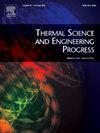Numerical and experimental investigation of blast furnace slag flow and thermoelectric generator-based heat recovery
IF 5.4
3区 工程技术
Q2 ENERGY & FUELS
引用次数: 0
Abstract
The flow characteristics and heat recovery potential of blast furnace (BF) slag are critical for enhancing energy efficiency in industrial processes. This study integrates a novel thermoelectric generator (TEG) above the BF slag runner to investigate the influence of thermoelectric module (TEM) structure on slag flow behavior and power generation. A predictive model was developed to accurately estimate BF slag viscosity based on composition and temperature. Baseline analysis of natural slag flow (without TEG) showed an outlet temperature of 1212.37 °C and a flow velocity of 2.89 m/min. Computational Fluid Dynamics (CFD) simulations and experiments demonstrated that integrating the TEG significantly enhanced performance. At a TEM height of 5.0 mm, the TEG achieved a maximum power output of 11.93 W at 16.77 V and 0.71 A, driven by a temperature difference of 198.33 °C. The installation of the TEG raised the area-weighted outlet temperature to 1364.63 °C and velocity to 10.73 m/min, while the volume-integrated temperature rose from 1317.92 °C to 1399.62 °C, and the mass-weighted outlet velocity increased from 3.82 m/min to 14.13 m/min. This optimized TEM height significantly improved heat retention and slag flow behavior. TEG integration enables efficient waste heat recovery while enhancing thermal transport and flow efficiency, presenting a promising approach for energy sustainability in industrial applications.
高炉渣流及热电发生器热回收的数值与实验研究
高炉炉渣的流动特性和热回收潜力对提高工业生产过程的能源效率至关重要。本研究将一种新型热电发生器(TEG)集成在高炉渣道上方,研究热电模块(TEM)结构对渣流行为和发电的影响。建立了基于炉渣成分和温度的炉渣粘度预测模型。自然渣流基线分析(不含TEG)表明,出口温度为1212.37℃,流速为2.89 m/min。计算流体动力学(CFD)模拟和实验表明,集成TEG可以显著提高性能。在TEM高度为5.0 mm时,TEG在16.77 V和0.71 a下的最大输出功率为11.93 W,驱动温差为198.33°C。TEG的安装使出口面积加权温度提高到1364.63℃,速度提高到10.73 m/min,体积积分温度从1317.92℃提高到1399.62℃,质量加权出口速度从3.82 m/min提高到14.13 m/min。优化后的TEM高度显著改善了蓄热性能和渣流性能。TEG集成可以有效地回收废热,同时提高热传输和流动效率,为工业应用中的能源可持续性提供了一种有前途的方法。
本文章由计算机程序翻译,如有差异,请以英文原文为准。
求助全文
约1分钟内获得全文
求助全文
来源期刊

Thermal Science and Engineering Progress
Chemical Engineering-Fluid Flow and Transfer Processes
CiteScore
7.20
自引率
10.40%
发文量
327
审稿时长
41 days
期刊介绍:
Thermal Science and Engineering Progress (TSEP) publishes original, high-quality research articles that span activities ranging from fundamental scientific research and discussion of the more controversial thermodynamic theories, to developments in thermal engineering that are in many instances examples of the way scientists and engineers are addressing the challenges facing a growing population – smart cities and global warming – maximising thermodynamic efficiencies and minimising all heat losses. It is intended that these will be of current relevance and interest to industry, academia and other practitioners. It is evident that many specialised journals in thermal and, to some extent, in fluid disciplines tend to focus on topics that can be classified as fundamental in nature, or are ‘applied’ and near-market. Thermal Science and Engineering Progress will bridge the gap between these two areas, allowing authors to make an easy choice, should they or a journal editor feel that their papers are ‘out of scope’ when considering other journals. The range of topics covered by Thermal Science and Engineering Progress addresses the rapid rate of development being made in thermal transfer processes as they affect traditional fields, and important growth in the topical research areas of aerospace, thermal biological and medical systems, electronics and nano-technologies, renewable energy systems, food production (including agriculture), and the need to minimise man-made thermal impacts on climate change. Review articles on appropriate topics for TSEP are encouraged, although until TSEP is fully established, these will be limited in number. Before submitting such articles, please contact one of the Editors, or a member of the Editorial Advisory Board with an outline of your proposal and your expertise in the area of your review.
 求助内容:
求助内容: 应助结果提醒方式:
应助结果提醒方式:


